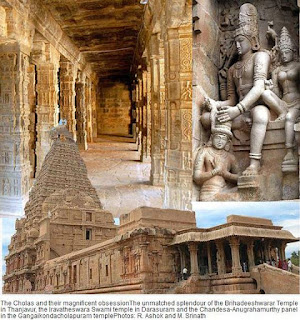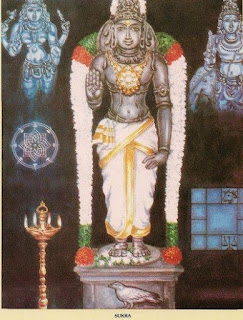Inside the Chola Temple
Event History scholars kept their audience spellbound with an action-packed account of the mighty Cholas, writes Pankaja Srinivasan
The clunk of chisel on stone fills the air. Instructions fly around. Priests, courtiers, masons and architects confer. The Natya Karanas (dance movements) are being carved into the wall of the corridor around the garbhagriha . Landmark judgements, donations and minutiae of day-to-day administration are inscribed on the outer rock walls. On the inside, artists capture scenes from the royal court, stories from the Puranas, gods, goddesses and creatures great and small. There is a tinkle of anklets, a rustle of silk, someone singing a Thevaram, someone else tuning a musical instrument…
The Brihadeeshwara temple as it must have been a thousand years ago coming alive as 12 speakers — a combination of scholars, researchers, writers and die-hard history enthusiasts — spirited us away to a time of the mighty Cholas and their marvels of engineering, the temples.
The focus of the two-day seminar organised by the Rotary Club of Metropolis was the heritage of the Cholas. The speakers lucidly described the temple — from its layout, vimana , garbhagruha and gopura to its symbolism, iconography, vaastu and its canons of architecture and rituals.
Professor S. Swaminathan explained the tradition and evolution of temple architecture, starting from the Pallavas to the Nayakas. He pointed out the change in the style of the sculptures from small and simple carvings to the increasingly voluptuous and grand. The Tamil Nadu temples were mostly square or rectangular (the shastras list 16 different shapes). Most importantly, these temples were repositories of art, music and dance.
A living monument
UNESCO described the Brihadeeshwara temple as ‘The great Living Chola Temple', said Chithra Madhavan in her lecture on the Brihadeeshwara temple. “Living” because people still visit, worship and use the temple premises like they did at the time of Raja Raja Chola.
It is a matter of pride that 80 per cent of temple inscriptions in India were in Tamil Nadu, and Chithra spoke of the calligraphy that was of the highest order, with a wealth of information contained in them. From the inscriptions one learns of the transfer of 400 dancing girls to the temple, where they lived, how much they were paid, who the musicians were and who were the choreographers! She spoke of the monolith Nandi, the paintings on the ceiling, the massive dwarapalakas…
She mourned the destruction of the Gangai Konda Chola Puram temple of Rajendra Chola. The British carried away huge chunks of it to build a dam. Even then the temple remains a jewel.
Parts of these grand monuments are forever closed to the public. But, thanks to the slide shows at the seminar, one travelled the secret passages around the sanctum sanctorum, gazed up the inside of the Sri Vimana and came within touching distance of frescoes and murals. Having worked tirelessly with the Archeologically Survey of India, P.S. Sriraman shared his breath taking experience of the work he and his team did in the dark, unlit, unventilated passage behind the sanctum sanctorum trying to photo-document the priceless works of art for posterity.
Building a dream
S. Rajendran who evaluates repairs and restores old heritage buildings gave a block by block explanation of the enviable engineering skills of the Cholas who put up structures that were built to last ad infinitum. The session ended with an eloquent description of the Darasuram temple by Kudavoil Balasubramaniyam who walked the gathering through every nook and cranny of the exquisite structure.
The brain behind the seminar, S. Gurumurthy, had reason to be pleased. From a class nine student Sanjay Krishna from Perianaickapalayam, architect K.V. Roshini and homemaker Renuka Seshachalam to professors of design Balaram and Padmini, students of history, doctors, artists…they filled the GKD Auditorium. “Spell bound”, “a sea of information”, “Awe-inspiring”, “Moving” were just some of the reactions. “I wanted it to reach out to everyone,” said Gurumurthy. “Our speakers were knowledgeable and held audience attention. Our apprehension whether such a subject would evoke interest were laid to rest.” Gurumurthy was besieged with requests to have more such programmes.
The seminar was inaugurated by Swami Dayananda Saraswati. It concluded with industrialist Ravi Sam, who is deeply involved in the conservation of south Indian temples, pledging his support to such endeavours and promising more heritage-related events for Coimbatore. The chief guest Babaji Raja Bhonsle, prince of Thanjavur, appreciated the interest in conserving heritage and lauded the effort of the organisers.
The other eminent panellists were R Nagaswamy, R. Gopu, Silpa Sastra scholar K.P. Umapathy Acharya, Aravind Venkatraman, sculptor P. Sivaramakrishnan and Marabin Maindhan Muthaiah.
The Brihadeeshwara temple as it must have been a thousand years ago coming alive as 12 speakers — a combination of scholars, researchers, writers and die-hard history enthusiasts — spirited us away to a time of the mighty Cholas and their marvels of engineering, the temples.
The focus of the two-day seminar organised by the Rotary Club of Metropolis was the heritage of the Cholas. The speakers lucidly described the temple — from its layout, vimana , garbhagruha and gopura to its symbolism, iconography, vaastu and its canons of architecture and rituals.
Professor S. Swaminathan explained the tradition and evolution of temple architecture, starting from the Pallavas to the Nayakas. He pointed out the change in the style of the sculptures from small and simple carvings to the increasingly voluptuous and grand. The Tamil Nadu temples were mostly square or rectangular (the shastras list 16 different shapes). Most importantly, these temples were repositories of art, music and dance.
A living monument
UNESCO described the Brihadeeshwara temple as ‘The great Living Chola Temple', said Chithra Madhavan in her lecture on the Brihadeeshwara temple. “Living” because people still visit, worship and use the temple premises like they did at the time of Raja Raja Chola.
It is a matter of pride that 80 per cent of temple inscriptions in India were in Tamil Nadu, and Chithra spoke of the calligraphy that was of the highest order, with a wealth of information contained in them. From the inscriptions one learns of the transfer of 400 dancing girls to the temple, where they lived, how much they were paid, who the musicians were and who were the choreographers! She spoke of the monolith Nandi, the paintings on the ceiling, the massive dwarapalakas…
She mourned the destruction of the Gangai Konda Chola Puram temple of Rajendra Chola. The British carried away huge chunks of it to build a dam. Even then the temple remains a jewel.
Parts of these grand monuments are forever closed to the public. But, thanks to the slide shows at the seminar, one travelled the secret passages around the sanctum sanctorum, gazed up the inside of the Sri Vimana and came within touching distance of frescoes and murals. Having worked tirelessly with the Archeologically Survey of India, P.S. Sriraman shared his breath taking experience of the work he and his team did in the dark, unlit, unventilated passage behind the sanctum sanctorum trying to photo-document the priceless works of art for posterity.
Building a dream
S. Rajendran who evaluates repairs and restores old heritage buildings gave a block by block explanation of the enviable engineering skills of the Cholas who put up structures that were built to last ad infinitum. The session ended with an eloquent description of the Darasuram temple by Kudavoil Balasubramaniyam who walked the gathering through every nook and cranny of the exquisite structure.
The brain behind the seminar, S. Gurumurthy, had reason to be pleased. From a class nine student Sanjay Krishna from Perianaickapalayam, architect K.V. Roshini and homemaker Renuka Seshachalam to professors of design Balaram and Padmini, students of history, doctors, artists…they filled the GKD Auditorium. “Spell bound”, “a sea of information”, “Awe-inspiring”, “Moving” were just some of the reactions. “I wanted it to reach out to everyone,” said Gurumurthy. “Our speakers were knowledgeable and held audience attention. Our apprehension whether such a subject would evoke interest were laid to rest.” Gurumurthy was besieged with requests to have more such programmes.
The seminar was inaugurated by Swami Dayananda Saraswati. It concluded with industrialist Ravi Sam, who is deeply involved in the conservation of south Indian temples, pledging his support to such endeavours and promising more heritage-related events for Coimbatore. The chief guest Babaji Raja Bhonsle, prince of Thanjavur, appreciated the interest in conserving heritage and lauded the effort of the organisers.
The other eminent panellists were R Nagaswamy, R. Gopu, Silpa Sastra scholar K.P. Umapathy Acharya, Aravind Venkatraman, sculptor P. Sivaramakrishnan and Marabin Maindhan Muthaiah.



Comments
Post a Comment